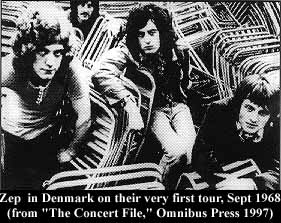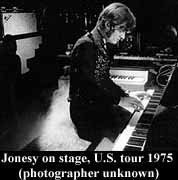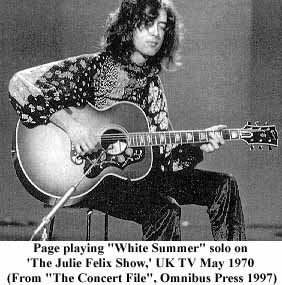

On the eve of the release of 'The Concert File' (due for release in May '97), here is an inside glimpse into how the book was put together by the authors themselves, via trans-Atlantic interview.
PROXIMITY: How much freedom did Omnibus Press give you in putting the book together in terms of content, layout and design?
DAVE LEWIS: Omnibus' Editor in Chief Chris Charlesworth oversaw the text but overall we had total control in terms of the content. I had a clear vision of the format I wanted from the start, i.e. a summary before each touring segment, relevant asides, full solo years appendix etc.
In terms of layout - having experienced the compromises that losing control can cause when I did 'Led Zeppelin: A Celebration' - I was very keen to have a strong advisory input into how the book looked. The designer Mike Warry worked very closely with us on the selection of photos and general layout. Luckily he is a Zeppelin fan himself and was very aware of the need to match the correct visual with the relevant date and era concerned. To that end I'm glad to report that there are no beards mysteriously infiltrating the visual side of things post-1971!
PROXIMITY:
The book is full of incredibly rare photos-such as Page with the
 Mickey Finn in the mid '60s and the 'New Yardbirds' in Scandinavia '68-how
did you go about finding and getting clearance for all those choice shots?
Mickey Finn in the mid '60s and the 'New Yardbirds' in Scandinavia '68-how
did you go about finding and getting clearance for all those choice shots?
DAVE LEWIS: One of the priorities with the book was to compliment the information being presented with some fresh visuals. There have been so many Zepp books now that getting away from the standard Neal Preston-type of shot can be very difficult. Luckily by leaving no stone unturned we came up with a variety of discoveries. In some cases this took months of careful negotiation, others I just stumbled upon.
The Mickey Finn shots turned up in a photo file from an agency Omnibus often uses. In the case of the Scandinavian photos, journalist Anne Bjorndal, who saw them many times during those early tours, is a reader of Tight But Loose and has often told me of the material she had in her post-session. Anne came over to London early last year and we met up. It was really like uncovering buried treasure when she brandished a set of photos that had been unseen outside of her collection for 27 years!
PROXIMITY: What was the most exciting find you uncovered while doing your research?
DAVE LEWIS: Visually it has to be the photo of The New Yardbirds taken on October 18, 1968. This arrived at Omnibus from a freelance photographer, Graham A. Wiltshire, who was on the rock and pop circuit during the late 60's and early 70's. It was a single transparency that Nikki Russell, the picture researcher at Omnibus, said looked "quite interesting!" I could hardly believe my eyes when I had it sent over. Graham told me it was the only photo he took that night. As an image of their embryonic days it really was some find.
With the text itself, one of the most vital additions to our research was the batch of U.S. cuttings provided by a certain H. Jones! We had no shortage of U.K. press material but reviews of dates such as the night they played in Kansas City using borrowed equipment were such an asset.
 SIMON PALLETT:
For me the whole experience has been one of discovery and
rediscovery. In listening to so many tapes I found that previously
underrated periods took on new meaning. The 1972 U.S. visit is a prime
example. Writing and logging their progress through the years has certainly
enhanced my own appreciation of the enormity of Led Zeppelin's
achievements as a live band. That's something we hope all readers of the
book will share.
SIMON PALLETT:
For me the whole experience has been one of discovery and
rediscovery. In listening to so many tapes I found that previously
underrated periods took on new meaning. The 1972 U.S. visit is a prime
example. Writing and logging their progress through the years has certainly
enhanced my own appreciation of the enormity of Led Zeppelin's
achievements as a live band. That's something we hope all readers of the
book will share.
PROXIMITY: How many new dates do you reckon you've uncovered, or wrong dates corrected, based on Godwin's 1995 itinerary as the most comprehensive (and recent) one?
SIMON PALLETT: It's difficult to put a figure on it all. It's really been a case of overhauling all the information that we have at our disposal and reassessing it. We've certainly benefitted from Robert Godwin's unselfish sharing of information. He took the time to verify some of our findings and add his own new discoveries.
PROXIMITY: What criteria was used for being absolutely certain of a 'suspicious' date?
DAVE LEWIS: A combination of factors. Press ads from the time, firsthand reviews, reminiscences from those that were there. We took all the available evidence and then made a decision. In the case of some dates, particularly the Scandinavian '68 period and various '69 dates, the jury may still be out on our outcome! We await the deluge of feedback from those that may question some of the listings, and I'll certainly be using the next issue of Tight But Loose as a platform for future Concert File discussion and revision.
 SIMON PALLETT:
We don't make any claim to this being a definitive listing,
so nothing's cast in stone. It's our own valiant attempt to get it as right
as possible but obviously it's open to question.
SIMON PALLETT:
We don't make any claim to this being a definitive listing,
so nothing's cast in stone. It's our own valiant attempt to get it as right
as possible but obviously it's open to question.
PROXIMITY: Only two dates are listed on the mysterious Spring tour of Europe in 1971. What kind of efforts did you put into researching this period, and could you confirm the June 1971 tour dates that Luis Rey listed in the last edition of his book?
SIMON PALLETT: One of the policies we stuck by was that if we were not one hundred percent sure on a date, we would not print it or speculate that it happened. With the spring '71 dates, as we state there may have been others performed but no clear evidence has come to light to verify them. One probable reason why that period saw them performing brief stints of dates rather than a full fledged tour is that they were very much tied up in remixing the fourth album at Island Studios, after the earlier mix at Sunset Sound in L.A. had not lived up to expectations. This would certainly have curtailed a full tour at the time. There seems to have been so little coverage in the European press for that period so it's all a little speculative. I believe Luis' new book makes the same point about this tour.
PROXIMITY: One of the outstanding things about the book are the many direct quotes from Peter Grant and others closely connected to the band. Did you have one major source for this material or did you simply compile it from various interviews over the years?
DAVE LEWIS:
From the onset we made a conscious effort to make sure the book
did not just read like a list of dates and setlists. Source material to
illuminate the text and capture the true spirit of the times was where the
bulk of our initial research was directed. This material was garnered from
Simon's collection, the TBL Archive, the input from contributors and also
talking to associates we had come into contact with who were there over the
years.
In the case of Peter Grant, much of the material comes from the two days I
spent talking with him in June and October of 1993, the last major
interview he gave before his passing. It was then that he made the
statement, "When Led Zeppelin gave a concert it wasn't just a concert, it
was an event." That really sums up the whole ethic of his steering of the
group to become what they did, and as big as they did. I would view the
strategy of their 1975 and 1977 touring operations as the blueprint for the
big scale tour concepts that exist today with the likes of U2.
Obviously, musically they had to have the chemistry to make it happen, but
Peter Grant's rewriting of the rulebook on how this band should be
presented live was equally important in carving their lasting live
legacy-which is why the book is dedicated to him.
PROXIMITY: In addition to your input from Peter Grant, how much cooperation did you seek and/or get in working on the book from the current Zeppelin organization?
DAVE LEWIS:
Chris Charlesworth is very active in the Trinifold camp with
the Who reissue programme, so they had knowledge of the project. However
with their schedule it's always very difficult to get direct involvement.
This is an independent Omnibus Press publication but we obviously hope they
view the end result favorably - it's certainly a book that should jog their
memories on the many remarkable moments they shared on stage all those
years ago.
For Proximity Subscription Information: CLICK HERE
![]()
Write Hugh Jones, Proximity Editor:
mrprox@mindspring.com